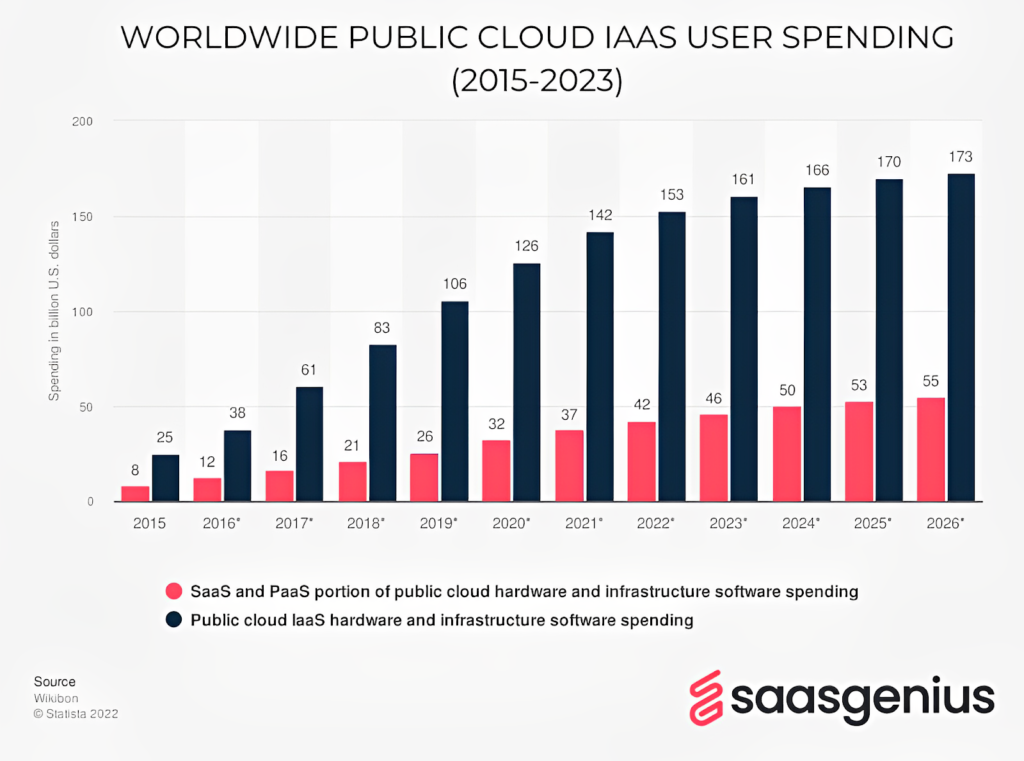Public Cloud Infrastructure as a Service (IaaS)
Public Cloud Infrastructure as a Service (IaaS) has become a popular choice for organizations and businesses looking to leverage the benefits of cloud computing services. This includes scalability, flexibility, and cost-effectiveness, among others. As a result, global spending on public cloud services is on the rise.

IaaS Market Size Statistics
The data illustrates global expenditure on public cloud infrastructure, enclosing both hardware and software, between 2015 and 2026. In 2024, the worldwide spending on public cloud IaaS hardware and software is predicted to reach $166 billion. The public cloud IaaS spending is rising each year at a steady pace, and exceeds SaaS and PaaS spending by at least three times the amount.
In 2023, the spending for cloud computing IaaS hardware and software has surpassed SaaS and PaaS spending by 115 billion US dollars. And although SaaS and PaaS spending is rising each year, by 2026, it is still expected to be much lower (a difference of 118 billion US dollars) than public cloud IaaS spending.
Do you know which kind of service you really need? Choosing a cloud-based service can be difficult if you don’t know the difference between them. Check out our article about SaaS, PaaS, and IaaS. Choose the best option for your business today!
Interesting Facts
What is Public Cloud Infrastructure as a Service?
Public cloud Infrastructure as a Service (IaaS) is a type of cloud computing service that provides virtualized computing resources over the internet. These include servers, storage, and networking capabilities. With IaaS, organizations can rent computing infrastructure on a pay-as-you-go basis from cloud providers. Otherwise, they would have to purchase and maintain their own physical hardware.
What is the Cloud Provider Responsible For?
In a public cloud IaaS environment, the cloud provider manages the underlying hardware. This includes servers, storage devices, and networking equipment. The service provider is responsible for hosting the users’ operating systems, development tools, and applications and conducting maintenance, backup, and disaster recovery services.
Users can then use these resources to deploy their own virtual machines, containers, or other software applications. The goal is for the users to manage and maintain everything themselves.
Who Are the Leading Cloud Providers?
The four leading cloud providers Amazon, Microsoft, Alibaba, and Google dominate the market, but other players are also making strides.
What Has Influenced the Drive for Public Cloud IaaS Demand?
- Cost-effectiveness: Public cloud IaaS enables organizations to rent computing resources on a pay-as-you-go basis, eliminating the need for significant upfront capital investments in hardware and software. It makes it more cost-effective for businesses to deploy and scale their infrastructure.
- Scalability and flexibility: Public cloud IaaS provides the flexibility to quickly scale up or down computing resources to match workload requirements. This enables organizations to handle unexpected surges in demand and adjust their resources to match seasonal or cyclical changes in business needs.
- Accessibility: Public cloud IaaS is accessible from any location with an internet connection, allowing remote workers to utilize the same infrastructure as their office-based counterparts. Businesses are able to operate easier in a distributed or remote work environment.
- Security: Public cloud IaaS providers invest heavily in security measures to protect their infrastructure and customers’ data, which enables businesses to leverage enterprise-level security capabilities without investing in their own security infrastructure.
- Technological advancements: Advancements in virtualization, automation, and containerization technologies have made it easier for businesses to deploy and manage their infrastructure in the cloud. This has increased the adoption of public cloud IaaS services.
- COVID-19 pandemic: The COVID-19 pandemic has accelerated the shift towards cloud infrastructure as businesses have had to quickly adapt to remote work environments and increased demand for digital services. Thanks to the pandemic, the need for public cloud IaaS has gone up even higher.
Summary
So what’s next when it comes to IaaS market growth? Overall, the IaaS market is likely to continue its growth as more organizations shift their IT infrastructure to the cloud. Providers that can offer flexible, scalable, and secure services that support these emerging trends will be well-positioned for success.
Author
Methodology
- Who?
We are SaaS experts: Our specialists constantly seek the most relevant information to help support your SaaS business. - Why?
We are passionate about users accessing fair SaaS pricing: We offer up-to-date pricing data, reviews, new tools, blogs and research to help you make informed SaaS pricing decisions. - How?
With accurate information: Our website manager tests each software to add a Genius Score using our rating methodology to each product. Our editorial team fact-check every piece of content we publish, and we use first-hand testing, value metrics and leading market data.